Speed test 4.21.1.13 beta vs. ...26 beta (test scene included)
 cgidesign
Posts: 442
cgidesign
Posts: 442
Just for fun I made a speed test between 4.21.1.13 and .26 beta.
General result is:
- ...13 is a bit faster when guided sampling and caustics are off, ...26 is a bit faster otherwise
- Memory consumption is nearly the same for both (the difference from render 9. upwards is related to other software not DS).
- Activating guided sampling for the test scene costs about 150MB vram.
- Guided sampling and / or caustics gives a way better result at fixed time of 8 min. even though the number of iterations is lower.
| 4.21.1.13 | 4.21.1.26 | |
| 1. fixed iterations 15000 | 7. fixed iterations 15000 | |
|
Scene loaded: 811 MB |
Scene loaded: 819 MB Render: 3967 MB guided off caustics off Time: 5,9 min Iterations: 15000 |
|
| 2. fixed iterations 15000 | 8. fixed iterations 15000 | |
| Scene loaded: 817 MB Render: 4132 MB guided on caustics off Time: 8.1 min Iterations: 15000 |
Scene loaded: 739 MB Render: 4049 MB guided on caustics off Time: 7,7 min Iterations: 15000 |
|
| 3. fixed iterations 15000 | 9. fixed iterations 15000 | |
| Scene loaded: 817 MB Render: 4095 MB guided on caustics on Time: 11,7 min Iterations: 15000 |
Scene loaded: 743 MB Render: 4071 MB guided on caustics on Time: 11,6 min Iterations: 15000 |
|
| 4. fixed time 8 min. (volume around scene) |
10. fixed time 8 min. (volume around scene) |
|
| Scene loaded: 817 MB Render: 3957 MB guided off caustics off Time: 8 min Iterations: 16561 |
Scene loaded: 754 MB Render: 3901 MB guided off caustics off Time: 8 min Iterations: 15455 |
|
| 5. fixed time 8 min. (volume around scene) |
11. fixed time 8 min. (volume around scene) |
|
| Scene loaded: 817 MB Render: 4089 MB guided on caustics off Time: 8 min Iterations: 11485 |
Scene loaded: 754 MB Render: 4065 MB guided on caustics off Time: 8 min Iterations: 11792 |
|
| 6. fixed time 8 min. (volume around scene) |
12. fixed time 8 min. (volume around scene) |
|
| Scene loaded: 817 MB Render: 4091 MB guided on caustics on Time: 8 min Iterations: 7835 |
Scene loaded: 751 MB Render: 4063 MB guided on caustics on Time: 8 min Iterations: 8104 |
EDIT
I have attached the test scene to this post now. Maybe somebody can test it with an older DS version? But I don't know if the custom volume shader I made works with older DS versions.
In general I am curious about the speed of a DS without "guided sampling". As seen in my tests the renders without guided sampling and without caustics create flat results that lack details of bounced and refracted light. In DS 4.21 the guided sampling does a good job showing those. I think in older DS versions this can only be achived with caustics. So it might be interesting to compare and old DS caustics with the new DS guided sampling.
Notes:
- In my scene the front and back walls were disabled. In the attached scene they are enabled now.
- The volume element is opaque in non iray view. To see the glass etc. you need to disable it in the scene tree or move your view into the volume.
- The volume.mdl is a custom one. It needs to be placed in the mdl directory of DS (see volume.mdl_path_readme.png).
- The normal map assigned to the table surface is of less quality than the one I used (90% quality jpg instead of png). The original png had a to big file size.
EDIT 2
The forum does not like me to upload the zip. So here is a google drive link.
https://drive.google.com/file/d/1aFx1E2zseRqW1WS3oM0fU_nP9blmt3z3/view?usp=sharing
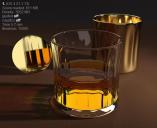

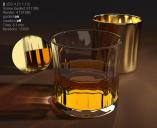

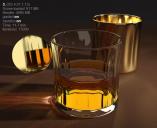

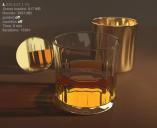

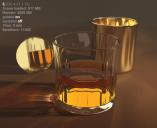

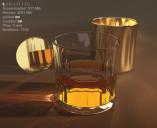

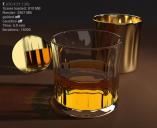

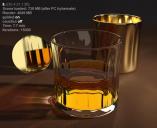

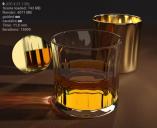

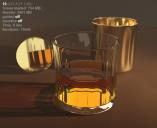

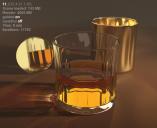

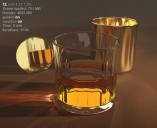



Comments
I ran the benchmark scene. It is technically faster than the previous 4.21. But that version was even slower than 4.20, which in turn was slower than 4.16.
Summary: New Iray 4.21: 78 seconds
Previous 4.21: 88 seconds
4.20: 78 seconds
4.16: 66 seconds
So you see what they did. They only fixed the performance regression from 4.20 to 4.21, and not the performance regression from 4.16 to 4.20. This is in the change log:
So they are blaming this a certain glossy surface. I find it funny that they say it is found in a popular benchmark scene. Pretty much every scene I made was slower than 4.16. But this regression may only apply to what happened between 4.20 and 4.21.1.13. Perhaps the cause of the regression after 4.16 is still unknown.
interesting - unfortunately I don't have a 4.16 backup, so I can't test with it. But I was anyway more interested to see the effect of guided sampling on vs. off. in this type of scene.
Would be interesting to see figures, if one compares a scene in 4.16 with no guided sampling (I think it was not implemented in that version) and 4.21 with guided sampling. Iterations per time might be better in 4.16 but what about image quality per iteration?
EDIT: Scene is now attached; see first post.
That's because I opened that ticket # with NVIDIA back on Oct 26, 2022, and pointed them to the forum benchmark scene. There's nothing funny to it -- they worked with what was reported to them.
If you can construct any other scenes that still exhibit performance regressions then post them and I can create another ticket.